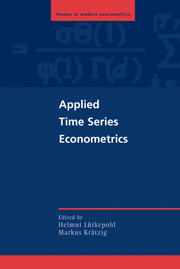Book contents
- Frontmatter
- Contents
- Preface
- Notation and Abbreviations
- List of Contributors
- 1 Initial Tasks and Overview
- 2 Univariate Time Series Analysis
- 3 Vector Autoregressive and Vector Error Correction Models
- 4 Structural Vector Autoregressive Modeling and Impulse Responses
- 5 Conditional Heteroskedasticity
- 6 Smooth Transition Regression Modeling
- 7 Nonparametric Time Series Modeling
- 8 The Software JMu⌉Ti
- References
- Index
3 - Vector Autoregressive and Vector Error Correction Models
Published online by Cambridge University Press: 23 November 2009
- Frontmatter
- Contents
- Preface
- Notation and Abbreviations
- List of Contributors
- 1 Initial Tasks and Overview
- 2 Univariate Time Series Analysis
- 3 Vector Autoregressive and Vector Error Correction Models
- 4 Structural Vector Autoregressive Modeling and Impulse Responses
- 5 Conditional Heteroskedasticity
- 6 Smooth Transition Regression Modeling
- 7 Nonparametric Time Series Modeling
- 8 The Software JMu⌉Ti
- References
- Index
Summary
Introduction
The first step in constructing a model for a specific purpose or for a particular sector of an economy is to decide on the variables to be included in the analysis. At this stage it is usually important to take into account what economic theory has to say about the relations between the variables of interest. Suppose we want to analyze the transmission mechanism of monetary policy. An important relation in that context is the money demand function, which describes the link between the real and the monetary sector of the economy. In this relationship a money stock variable depends on the transactions volume and opportunity costs for holding money. As an example we consider German M3 as the money stock variable, GNP as a proxy for the transactions volume, a long-term interest rate R as an opportunity cost variable, and the inflation rate Dp = Δp, where p denotes the log of the GNP deflator. The latter variable may be regarded as a proxy for expected inflation, which may also be considered an opportunity cost variable. Because the quantity theory suggests a log linear relation, we focus on the variables m = log M3 and gnp = log GNP. Seasonally unadjusted quarterly series for the period 1972–98 are plotted in Figure 3.1. Of course, many more variables are related to the presently considered ones and, hence, could be included in a model for the monetary sector of the economy. However, increasing the number of variables and equations does not generally lead to a better model because doing so makes it more difficult to capture the dynamic, intertemporal relations between them.
- Type
- Chapter
- Information
- Applied Time Series Econometrics , pp. 86 - 158Publisher: Cambridge University PressPrint publication year: 2004
- 47
- Cited by



